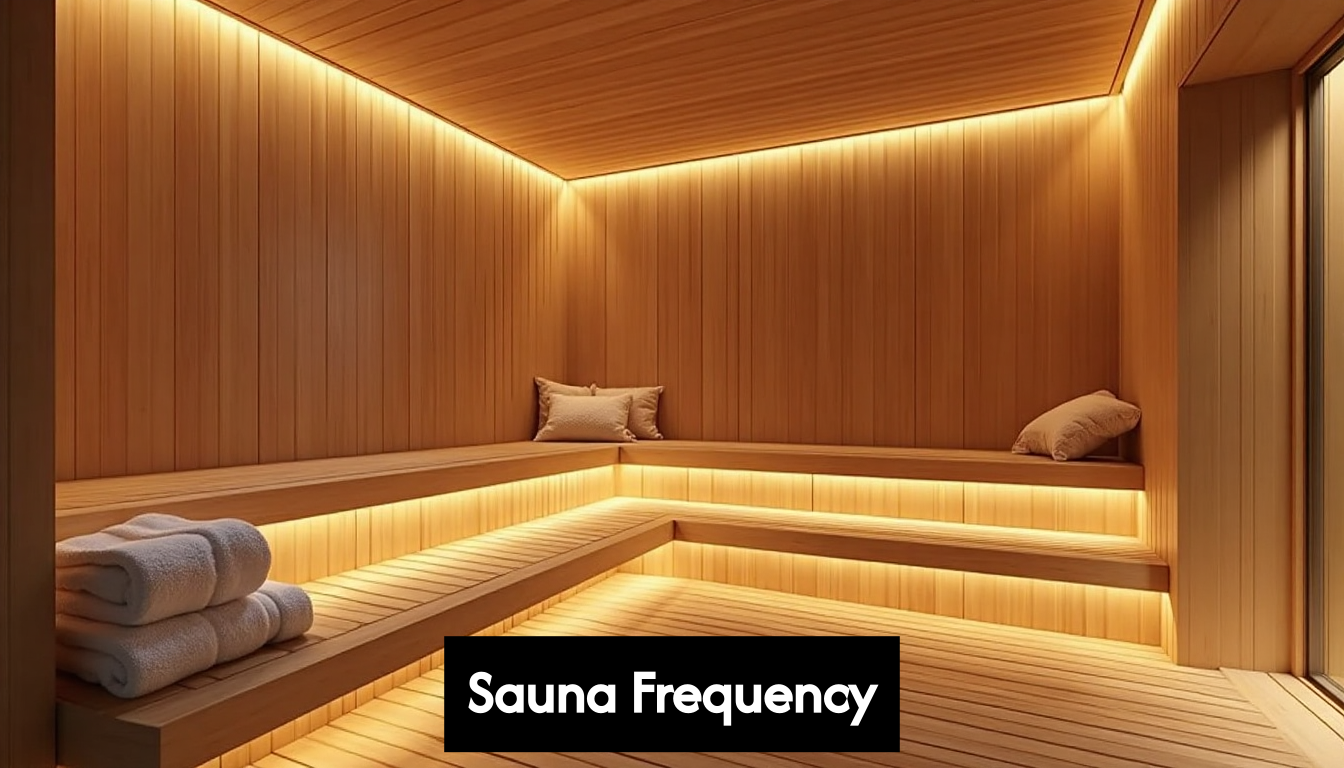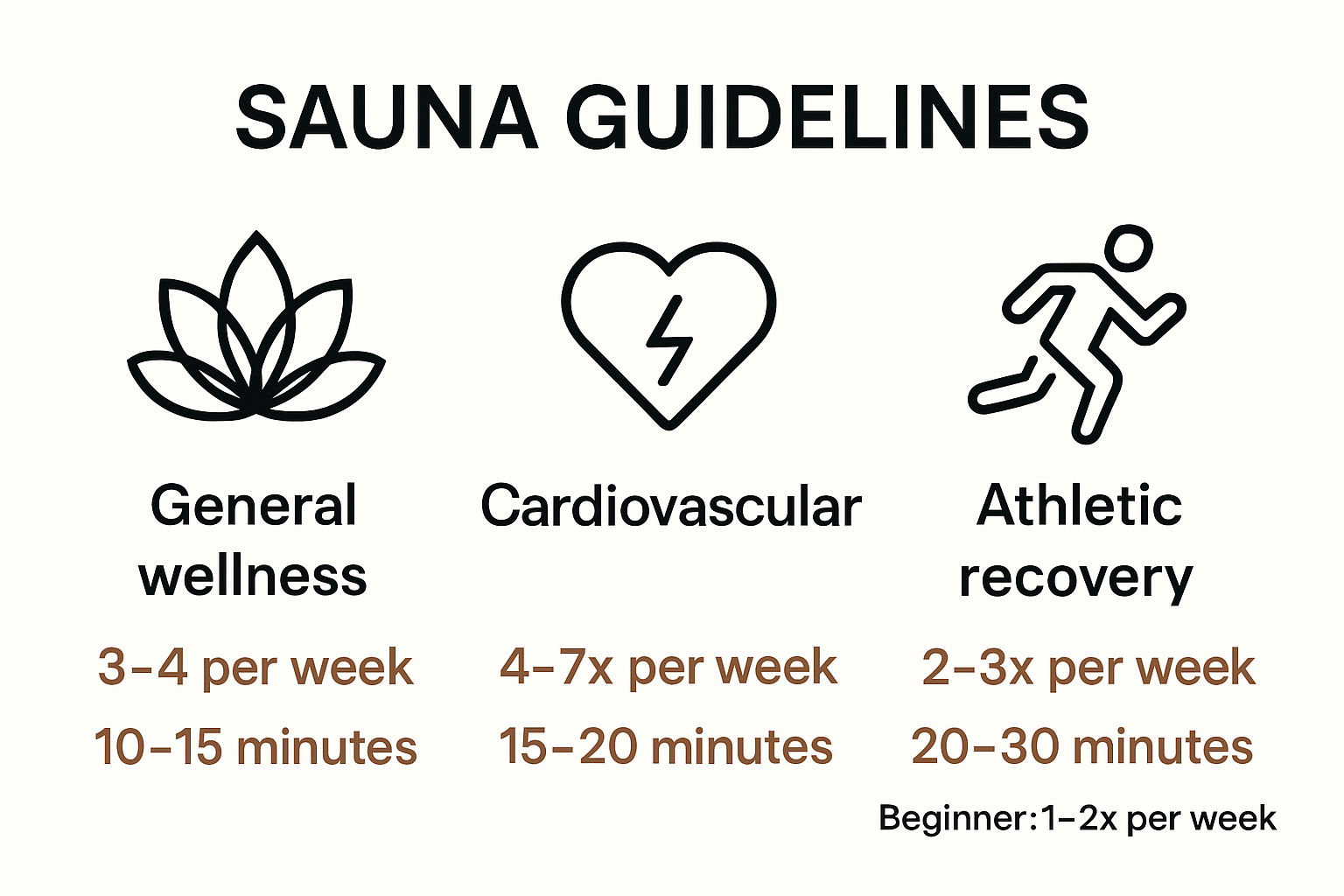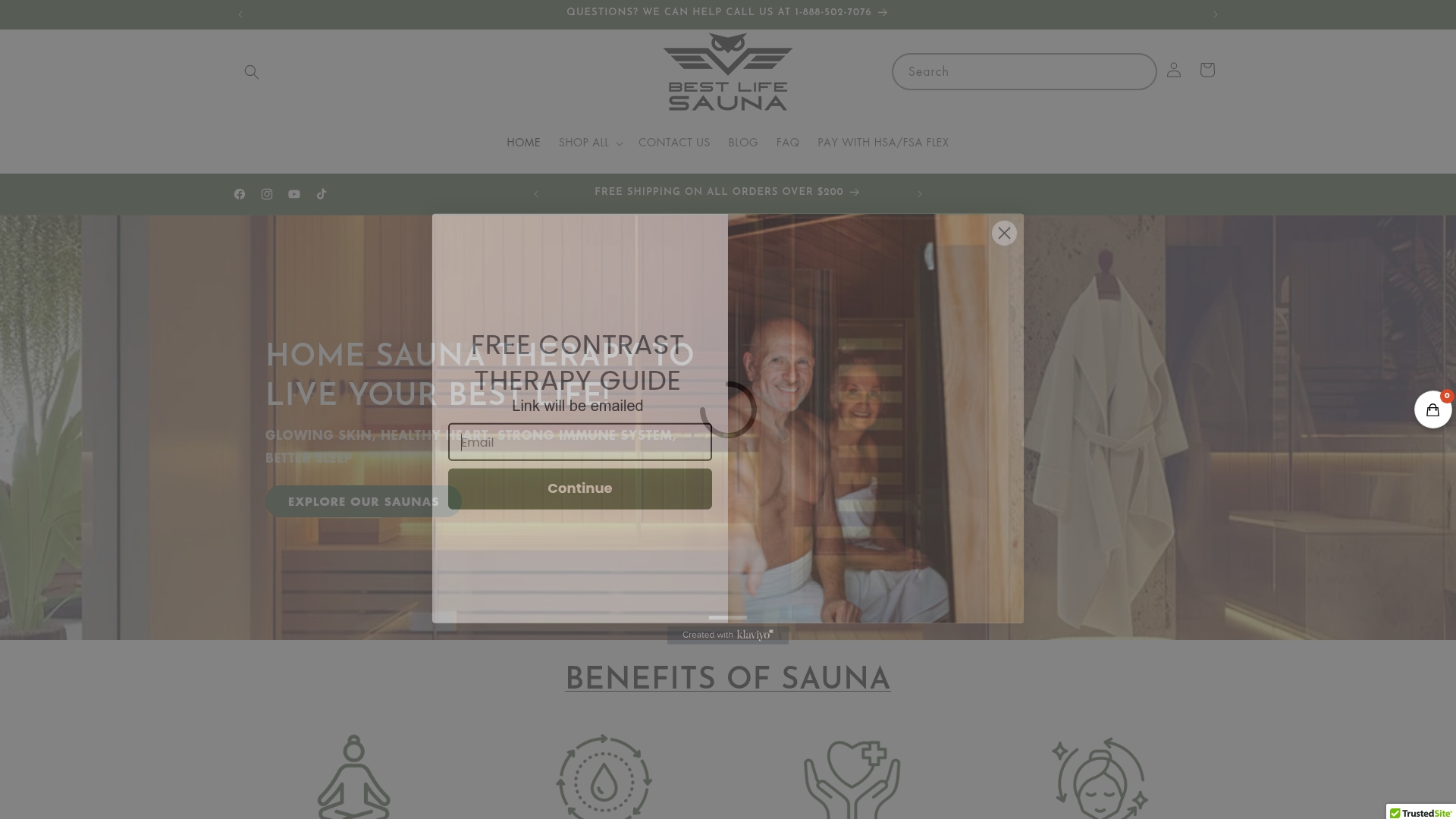
Sauna Frequency Recommendations: How Often Should You Use a Sauna in 2025?

Most people step into a sauna for relaxation or recovery, expecting a quick sweat to do the trick for their health. Here is the jaw-dropper. Using a sauna 3-4 times a week can slash all-cause mortality risk by up to 40 percent compared to only once per week. It sounds like more is always better, right? The truth is, the secret to reaping these benefits is not just piling on extra sessions, but matching your sauna visits exactly to your health goals—and in some cases, doing less might help you much more.
Table of Contents
- Understanding Sauna Frequency And Wellness Goals
- Recommended Sauna Sessions By User Type
- Risks, Precautions, And Signs To Reduce Frequency
- Tips For Creating The Best Sauna Routine At Home
Quick Summary
| Takeaway | Explanation |
|---|---|
| Personalize Your Sauna Routine | Tailor sauna frequency based on individual wellness goals: 2-4 sessions weekly for general wellness, 3-4 for cardiovascular health, and 4-5 for recovery in athletes. |
| Use Appropriate Session Parameters | Aim for sauna temperatures between 79-85°C (175-185°F) for durations of 20-30 minutes to maximize health benefits, with gradual adaptation recommended for beginners. |
| Be Mindful of Health Risks | Individuals with pre-existing health conditions, such as cardiovascular issues, should consult healthcare professionals before starting sauna use and recognize signs to limit frequency, such as dizziness or fatigue. |
Understanding Sauna Frequency and Wellness Goals
Optimizing sauna use requires a strategic approach tailored to individual wellness objectives. While saunas offer numerous health benefits, understanding how frequency impacts your specific goals becomes crucial for maximizing physiological advantages.
Individual Wellness Objectives and Sauna Frequency
Personal wellness goals dramatically influence recommended sauna session frequency. According to Home Health Research, general wellness seekers typically benefit from 2-4 sauna sessions per week, each lasting 15-20 minutes. However, targeted outcomes demand nuanced approaches.
Athletes focusing on recovery might require more frequent sessions, potentially 4-5 times weekly. Those targeting cardiovascular health could see significant improvements with consistent 3-4 weekly sessions. Stress management goals might align better with shorter, more frequent visits, while weight management enthusiasts could leverage slightly longer, less frequent sauna experiences.
Scientific Insights on Optimal Sauna Usage
Research provides compelling evidence about sauna frequency’s impact on overall health. A groundbreaking study revealed that using a sauna 3-4 times per week can reduce all-cause mortality by up to 40% compared to once-weekly use. Ora Health Research suggests optimal session parameters include temperatures between 79-85°C (175-185°F) and durations of 20-30 minutes.
Interestingly, Psychological Research indicates that regular sauna users report higher energy levels, improved overall health, and increased happiness compared to non-users. This underscores the profound connection between consistent sauna practice and holistic wellness.

Progressive Sauna Integration Strategies
For newcomers to sauna therapy, a gradual approach is recommended. Start with lower frequencies and shorter durations, allowing your body to adapt. Beginners might begin with 1-2 sessions weekly, lasting 10-15 minutes, and progressively increase intensity and frequency.
Consider your current health status, fitness level, and wellness objectives when designing your sauna routine. Individuals with pre-existing health conditions should consult healthcare professionals before establishing a regular sauna practice. Hydration, proper cooldown, and listening to your body remain critical components of a safe and effective sauna experience.
Remember that sauna frequency is not a one-size-fits-all recommendation. Your unique physiological response, lifestyle, and wellness goals will ultimately determine the most beneficial approach to integrating sauna sessions into your health regimen.
Recommended Sauna Sessions by User Type

Sauna usage varies significantly across different user types, with each group requiring tailored approaches to maximize health benefits and minimize potential risks. Understanding these nuanced recommendations helps individuals optimize their sauna experience based on their specific health profile and wellness objectives.
Athletes and Fitness Enthusiasts
For athletes and fitness enthusiasts, sauna sessions play a critical role in recovery and performance enhancement. Home Health Research recommends 3-4 post-workout sauna sessions per week, each lasting 15 minutes. Athletes can benefit from slightly longer 20-minute sessions on dedicated recovery days, helping to reduce muscle soreness and improve overall physiological adaptation.
Heat exposure triggers similar physiological responses to moderate cardiovascular exercise, making saunas particularly valuable for athletes seeking enhanced recovery. Endurance athletes might find additional benefits from more frequent sessions, potentially increasing to 4-5 times weekly, with careful attention to hydration and overall body response.
Health and Wellness Seekers
General wellness enthusiasts have more flexible sauna frequency recommendations. Ora Health Research highlights insights from experts like Dr. Rhonda Patrick and Dr. Peter Attia. Their recommendations range from 3-7 weekly sessions, with optimal durations of 20-30 minutes at temperatures between 79-85°C.
Individuals managing stress, seeking cardiovascular health improvements, or aiming for general wellness typically benefit from 2-4 sessions weekly. Those with specific health goals such as weight management or stress reduction might adjust their frequency and duration accordingly. For instance, stress management might favor more frequent but shorter sessions, while weight loss goals could involve longer, less frequent sauna experiences.
Special Populations and Careful Considerations
Certain user groups require more personalized approaches to sauna use. Older adults, individuals with pre-existing health conditions, and those with limited heat tolerance should adopt a more conservative strategy. Beginners should start with shorter sessions (10-15 minutes) at lower temperatures, gradually increasing duration and intensity as their body adapts.
Pregnant women, individuals with cardiovascular issues, and those on certain medications should consult healthcare professionals before establishing a sauna routine. Some medical conditions may require complete avoidance or significant modifications to sauna frequency and duration.
Medical professionals consistently emphasize the importance of individual assessment. Your unique physiological response, overall health status, and personal wellness goals should guide your sauna frequency. Listening to your body, maintaining proper hydration, and paying attention to how you feel during and after sessions are crucial for a safe and beneficial sauna experience.
Ultimately, sauna usage is a personal journey. While general guidelines provide valuable direction, individual adaptation and careful monitoring remain key to developing an effective and enjoyable sauna practice.
Risks, Precautions, and Signs to Reduce Frequency
While saunas offer numerous health benefits, understanding potential risks and implementing appropriate precautions is crucial for safe and effective use. Not all individuals can or should use saunas with the same frequency, and recognizing warning signs becomes essential for maintaining overall health and wellness.
Health Conditions and Sauna Contraindications
Home Health Research highlights several health conditions that require careful consideration before sauna use. Individuals with cardiovascular disease, low blood pressure, recent heart surgery, or active infections should exercise extreme caution. Pregnant women, people with neurological disorders, and those taking medications that impair heat regulation need personalized medical guidance.
Certain medical conditions can significantly increase risks associated with sauna use. Conditions like multiple sclerosis, diabetes with neuropathy, and severe obesity may compromise the body’s ability to regulate temperature effectively. These individuals should consult healthcare professionals to determine whether sauna therapy is appropriate and, if so, under what specific conditions.
Recognizing Warning Signs and Limiting Frequency
Ora Health Research recommends a cautious approach for beginners, starting with one session per week and gradually increasing frequency. Warning signs that indicate the need to reduce sauna frequency or seek medical advice include:
- Persistent Fatigue: Excessive tiredness that continues beyond the sauna session
- Dizziness or Lightheadedness: Prolonged sensations of unsteadiness or near-fainting
- Unusual Heart Rhythms: Rapid or irregular heartbeats during or after sauna use
- Severe Dehydration: Symptoms like extreme thirst, dark urine, or reduced urination
- Skin Irritation: Unusual rashes, excessive redness, or prolonged skin sensitivity
Safe Sauna Practices and Gradual Adaptation
Mitigating risks requires a strategic and mindful approach to sauna use. Beginners should start at lower temperatures (60-65°C) and shorter durations, incrementally increasing intensity as the body adapts. Hydration plays a critical role in safe sauna practice. Drink water before, during, and after sauna sessions to prevent dehydration and support the body’s natural cooling mechanisms.
Age is another important factor in determining sauna frequency and duration. Older adults may have reduced heat tolerance and slower recovery mechanisms. They should be particularly cautious, starting with shorter, less frequent sessions and paying close attention to their body’s responses.
Alcohol consumption before or during sauna use dramatically increases health risks. Alcohol impairs the body’s ability to regulate temperature and can lead to rapid dehydration, increased heart rate, and potential cardiovascular complications. It is strongly recommended to avoid alcohol before and during sauna sessions.
Individual variability means there is no universal sauna frequency that suits everyone. Your unique health status, fitness level, and physiological response should guide your sauna practice. Regular medical check-ups and open communication with healthcare providers can help you develop a safe, personalized sauna routine that supports your wellness goals while minimizing potential risks.
Tips for Creating the Best Sauna Routine at Home
Designing an effective home sauna routine requires careful planning, personal consideration, and a strategic approach to maximize health benefits while ensuring safety and enjoyment. Understanding the nuances of creating a personalized sauna practice can transform your wellness experience.
Establishing a Foundational Sauna Schedule
Ora Health Research recommends a progressive approach to developing a home sauna routine. Beginners should start with one session per week, gradually increasing frequency to 3-4 sessions weekly. Initial sessions should last 10-15 minutes at lower temperatures (60-65°C), incrementally building to 20-30 minute sessions at 79-85°C as your body adapts.
Consistent spacing between sessions is crucial. Home Health Research suggests allowing at least 24 hours between sauna sessions to support proper recovery and prevent potential overexertion. This approach helps your body maximize the physiological benefits while avoiding unnecessary stress.
Optimizing Your Sauna Recovery and Performance
Enhancing your sauna routine involves more than just frequency. Incorporating recovery techniques can significantly improve overall results. Ora Health Research highlights the benefits of contrast therapy—alternating between hot sauna sessions and cold showers or ice baths. This technique can help decrease inflammation, improve muscle recovery, and boost overall cardiovascular resilience.
Tailor your sauna frequency to specific wellness goals. For stress management, 2-3 weekly sessions might be ideal. Athletes seeking recovery could benefit from 3-4 sessions, while those targeting weight management might aim for up to 4-7 sessions weekly. The key is personalization and attentive body monitoring.
Creating a Holistic Home Sauna Environment
Beyond frequency, the environment and preparation significantly impact your sauna experience. Invest in high-quality towels, create a relaxing pre and post-sauna ritual, and ensure proper hydration. Consider keeping a dedicated water bottle, electrolyte supplements, and comfortable changing area near your sauna.
Mindfulness plays a critical role in maximizing sauna benefits. Use this time for meditation, deep breathing, or gentle stretching. Avoid digital devices and create a tranquil atmosphere that supports both physical and mental recovery. Some individuals find success in journaling or practicing guided relaxation techniques during their sauna sessions.
Preparing your body before and after sauna use is equally important. Shower before entering to remove oils and dirt, and follow each session with proper hydration and potentially a light, nutritious meal. Pay attention to your body’s signals—if you feel excessive fatigue or discomfort, adjust your routine accordingly.
Remember that your sauna routine is a personal journey of wellness. What works perfectly for one individual might require modification for another. Regular self-assessment, openness to adjustment, and maintaining communication with healthcare professionals will help you develop a sauna practice that genuinely supports your health and wellness goals.
Frequently Asked Questions
How often should I use a sauna for general wellness?
You should aim for 2-4 sauna sessions per week, each lasting about 15-20 minutes to support overall wellness.
What are the recommended sauna sessions for athletes?
Athletes should use the sauna 3-4 times weekly for recovery, with sessions lasting 15-20 minutes, and possibly increasing to 4-5 times per week for enhanced benefits.
Is there a specific temperature range I should maintain in the sauna?
Yes, the optimal sauna temperature range is between 79-85°C (175-185°F) for maximum health benefits during sessions lasting 20-30 minutes.
What should I do if I feel dizzy or fatigued during a sauna session?
If you experience dizziness, fatigue, or any other unusual symptoms, it is essential to exit the sauna immediately, hydrate, and consult a healthcare professional if symptoms persist.
Experience Your Best Sauna Routine at Home in 2025
Are you ready to unlock all the benefits of optimal sauna frequency and make every session count for your health? Many readers want the stress relief, improved circulation, and overall wellness described in our guide, but struggle to find the right sauna setup for their personal goals. You deserve a solution that matches your wellness journey and upgrades your home into a sanctuary for restoration and energy. At Best Life Sauna, we provide premium traditional, infrared, and outdoor saunas plus wellness accessories so you have everything you need to build your perfect routine right at home.

Start your transformation today. Browse top-rated saunas and wellness solutions at Best Life Sauna and discover exclusive offers that make launching your customized routine simple and affordable. Stress less, feel better, and take action now to enjoy free shipping on orders over $200. Your next-level wellness begins with one click.

